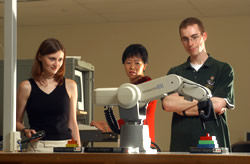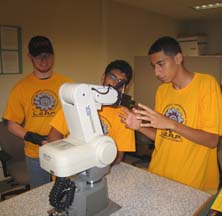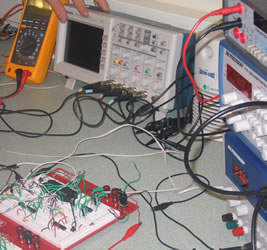Dr. Martin v. Mohrenschildt
|
|
Associate Professor Dr. sc. math. ETH., Dipl. math. ETH., P.Eng. Computing and Software Faculty of Engineering McMaster University Phone: (905) 525-9140 ex. 23844 Office: ITB 164 E-Mail: mohrens@mcmaster.ca FAX: (905) 521-2922 |
Research Interests
- CAS-748 (Term II) 2025 Time Series Analysis
- MECHTRON/ SFWR ENG 3MX3 (Term I) 2024 Signals and Systems
- MECHTRON 4AX3 (Term I) 2024 Predictive and Intelligent Control
- SFWR ENG 2SO3 (Term II) DONE
- SFWR ENG 3KO4 (Term I) DONE
- SFWR ENG 3GP6 (Term III) DONE
- Wavelet-Based Estimation of Damping from Multi-Sensor, Multi-Impact Data HM Daniali, M Mohrenschildt Signals 6 (1), 2025
- Impact of Data Leakage in Vibration Signals Used for Bearing Fault Diagnosis L Wheat, M Mohrenschildt, S Habibi, D Al-Ani IEEE Access 2024
- A Camera-LiDAR Fusion Framework for Traffic Monitoring A Sochaniwsky, Y Huangfu, S Habibi, M Von Mohrenschildt, R Ahmed, 2024 IEEE Transportation Electrification Conference and Expo (ITEC), 1-6, 2024
- Locally-scaled kernels and confidence voting E Hofer, M v. Mohrenschildt Machine Learning and Knowledge Extraction 6 (2), 1126-1144, 2024
- Evaluating the Effects of Motion Cues in Virtual Truck Driver Training Y Jabbari, M Mohrenschildt Transportation Research Record, 03611981241283457, 2024
- An EMG-Based Biofeedback System for Tailored Interventions Involving Distributed Muscles SL Toepp, MV Mohrenschildt, AJ Nelson IEEE Sensors Journal 23 (22), 28095-28109, 2023
- Stimulus Onset Asynchrony Affects Weighting-related Event-related Spectral Power in Self-motion Perception B Townsend, JK Legere, M v. Mohrenschildt, JM Shedden Journal of Cognitive Neuroscience 35 (7), 1092-11072023
- Beta-band power is an index of multisensory weighting during self-motion perception B Townsend, JK Legere, M Mohrenschildt, JM Shedden Neuroimage: Reports 2 (3), 100102 2022
- Testing landmark-specific effects on route navigation in an ecologically valid setting: a simulated driving study Y Jabbari, DM Kenney, M von Mohrenschildt, JM Shedden Cognitive Research: Principles and Implications 7 (1), 22 2022
- Model-Free Data Mining of Families of Rotating Machinery E Hofer Applied Sciences 12 (6), 3178 2022
- Vestibular cues improve landmark-based route navigation: A simulated driving study Y Jabbari, DM Kenney, M von Mohrenschildt, JM Shedden Memory & Cognition 49 (8), 1633-1644 2021
- Visual-vestibular integration is preserved with healthy aging in a simple acceleration detection task DM Kenney, Y Jabbari, M von Mohrenschildt, JM Shedden Neurobiology of Aging 104, 71-81 2021
- A novel method for approximating object location error in bounding box detection algorithms using a monocular camera B Miethig, Y Huangfu, J Dong, J Tjong, M Von Mohrenschildt, S Habibi IEEE Transactions on Vehicular Technology 70 (9), 8682-8691 6 2021
- Velocity influences the relative contributions of visual and vestibular cues to self-acceleration DM Kenney, S O’Malley, HM Song, B Townsend, M von Mohrenschildt, Experimental brain research 238, 1423-1432 2020
- Leveraging thermal imaging for autonomous driving B Miethig, A Liu, S Habibi, M Mohrenschildt 2019 IEEE Transportation Electrification Conference and Expo (ITEC), 1-5 2019
- Attention modulates event-related spectral power in multisensory self-motion perception B Townsend, JK Legere, S O'Malley, M Mohrenschildt, JM Shedden Neuroimage 191, 68-80 2019
- Portable electromyography: A case study on ballistic finger movement recognition A Shaabana, J Legere, J Li, R Zheng, MV Mohrenschildt, JM Shedden IEEE Sensors Journal 19 (16), 7043-7055 2019
- A probability occupancy grid based approach for real-time LiDAR ground segmentation Z Luo, MV Mohrenschildt, S Habibi IEEE Transactions on Intelligent Transportation Systems 21 (3), 998-1010 2019
- Online multiple maneuvering vehicle tracking system based on multi-model smooth variable structure filter Z Luo, M Attari, S Habibi, M Von Mohrenschildt IEEE Transactions on Intelligent Transportation Systems 21 (2), 603-616 2019
- Finger movement recognition during ballistic movements using electromyography A Shaabana, R Zheng, J Legere, MV Mohrenschildt 2017 IEEE/ACM International Conference on Connected Health: Applications 2017
- LiDAR based perception system: Pioneer technology for safety driving Z Luo 2017
- Exposure to Disturbance Motion During Practice in an Analog of a Flight Task Influences Flight Control of Naive Participants S O’Malley, A Rajagobal, JG Grundy, MV Mohrenshildt, JM Shedden The International Journal of Aviation Psychology 26 (3-4), 63-74 2016
- The effectiveness of simulator motion in the transfer of performance on a tracking task is influenced by vision and motion disturbance cues JG Grundy, S Nazar, S O’Malley, MV Mohrenshildt, JM Shedden Human factors 58 (4), 546-559 2016
- LiDAR based real time multiple vehicle detection and tracking Z Luo, S Habibi, MV Mohrenschildt International Journal of Computer and Information Engineering 10 (6), 1125-1132 2016
- Isolating the Contribution of Disturbance Cues from Physical Motion on Training in a Motion Simulator S O'Malley, A Rajagobal, J Legere, M von Mohrenschildt, JM Shedden, CANADIAN JOURNAL OF EXPERIMENTAL PSYCHOLOGY-REVUE CANADIENNE DE PSYCHOLOGIE 2015
- Electrophysiological Correlates of Visual-Vestibular Integration B Townsend, S O'Malley, J Legere, M von Mohrenschildt, JM Shedden CANADIAN JOURNAL OF EXPERIMENTAL PSYCHOLOGY-REVUE CANADIENNE DE PSYCHOLOGIE 2015
- The integration of physical acceleration cues with visual acceleration cues S O'Malley, B Townsend, M von Mohrenschildt, JM Shedden Canadian Journal of Experimental Psychology-Revue Canadienne de Psychologie 2015
- Does Training With Self-Motion Improve Target Tracking Performance in a Three-Dimensional Environment? S Nazar, JG Grundy, S O'Malley, M von Mohrenschildt, JM Shedden CANADIAN JOURNAL OF EXPERIMENTAL PSYCHOLOGY-REVUE CANADIENNE DE PSYCHOLOGIE 2014
- Functional Motion Threshold: The Role of Practice When Discriminating Direction in a Turbulent Motion Simulator JG Grundy, S Nazar, S O'Malley, DC Chung, MV Mohrenschildt, CANADIAN JOURNAL OF EXPERIMENTAL PSYCHOLOGY-REVUE CANADIENNE DE PSYCHOLOGIE 2014
- M. v. Mohrenschildt, (2005), "A Hybrid Controller for a Nonholonomic Car-like Robot", International Conference on informatics in Control, Automation and Robotics, ICINCO 2005, September (14-17) in Barcelona/Spain.
- M. v. Mohrenschildt, (2005), "Model Predictive Traces", Journal of Software Engineering and Knowledge Engineering, Special Issue: Selected Papers from the 2005 International Conference on Embedded and Hybrid Systems, Vol. 15, No. 2 (April 2005), 289-298.
- M. v. Mohrenschildt, (2005), "Model Predictive Traces in Hybrid Systems", International Conference on Hybrid Systems, IEHSC'05
- W. M. Farmer, M. v. Mohrenschildt, (2004), "Simple Type Theory: Simple Steps towards a formal Specification", In the Proceedings of the FIE 2004.
- W. M. Farmer, M. v. Mohrenschildt, (2003), "A Formal Framework for Managing Mathematics", Annals of Mathematics and Artificial Intelligence, May 2003, Volume 38, Issue 1-3, pp. 165-191
- N. Nedialkov, M. v. Mohrenschildt (2002), "Rigorous Simulation of Hybrid Dynamic Systems with Symbolic and Interval Methods", ACC 2002, 7 pages. PDF
- M. v. Mohrenschildt (2001), "Symbolic Verification of Hybrid Systems: An Algebraic Approach", European Journal of Control, Vol 7, Num 5, 2001 pp: 541-556. PDF
- W. M. Farmer and M. v. Mohrenschildt, (2001), "A formal framework for managing mathematics", Electronic Proceedings of the First International Workshop on Mathematical Knowledge Management: MKM'2001, 38 pp., RISC, Hagenburg, Austria, September 24-26, 2001.
- W. M. Farmer, M. v. Mohrenschildt (2000), "Transformers for Symbolic Computation and Formal Deduction", , Proceedings of the Workshop on the Role of Automated Deduction in Mathematics, pp. 36-45, CADE-17, Carnegie Mellon University, Pittsburgh, Pennsylvania, June 20-21, 2000.
- M. v. Mohrenschildt, (2000), "Hybrid Differential Equations and Hybrid Systems", SCI'2000/ISAS'2000.
- M. v. Mohrenschildt, (2000), "Hybrid Systems: Solutions, Stability, Control", ACC 2000, 692-698
- M. v. Mohrenschildt, (1999), "Algebra of Normal Function Tables ", "Formal Aspects of Computing", 12(1):41-51, (2000).
- M. v. Mohrenschildt, (1999) "Symbolic Verification of Hybrid Systems", In the proceedings of IMACS/IEEE 99 Athens, July 4 - 8, 1999, pp 1511-1519 also in Software and Hardware Engineering for the 21th Century, World Scientific Engineering Society (1999).
- M. v. Mohrenschildt, (1998) "A Normal Form for Rings of Piecewise Functions", Journal of Symbolic Computation(1998) 26(5), 607-619 PDF
- M. v. Mohrenschildt, "Using Piecewise to Solve Classes of Control Theory Problems", MapleTech97, Vol .4, No. 3, pp. 33-3
- M. v. Mohrenschildt, D. Peters, The Draw-Bot: A software Engineering Project (1998) In the proceedings of the Frontiers of Engineering Education FIE98
- M. v. Mohrenschildt, The Maze Tracing Robot, Technical Report 1998, PDF
- D.J. Jeffrey, G. Labahn, M. v. Mohrenschildt, A.D. Rich (1997) Integration of signum, piecewise and related functions. In proceedings ISSAC 97, 324-330.
- M. v. Mohrenschildt, (1999), "Communicating Software Specifications using XML: OpenSpec", CRL REPORT 373
- M. v. Mohrenschildt, (1997) "Closed Form Solutions of Hybrid Systems", CRL Report 371, Feb 1999
- M. v. Mohrenschildt, (1997) "Algebra of Normal Functions Tables", CRL Report 315, McMaster University, NSERC, CRL, May 1997
Model Predictive
Control
The
objective in control is to determine inputs to a system such that the outputs
exhibit the desired behavior. In practice the input can not be chosen entirely
freely but has to satisfy constraints. Many different control strategies
have been developed to solve this problem including control strategies
for hybrid systems. In situations where optimal operation is at an extremum
of the constraint set or the process is nonlinear one single control strategy
can not satisfy all objectives over the entire runtime of the system and
it is difficult to handle constraints with some control strategies. To
overcome these problems we propose a control algorithm that combines several
different control strategies into one controller.
Vibration Analysis
Since about 2004 we research signal processing, especially related to vibration analysis.
We are actively engaged with industry in developing new approaches to extract health information
and machine characteristics using sensors (e.g. accelerometers) attached to large operating
mechanical machinery.
Hybrid Systems
In
engineering mathematics discontinuities appear in many equations. Based
on our theory for closed form solutions of differential equations with
piecewise coefficients or perturbation, we perform further research on
the theoretical and computational aspect of piecewise functions.
Immersive Simulation
Together with Dr. Shedden from Neuroscience we are investigating the effects
of a fully immersive environment (motion simulator) on humans.
One goal is to further our
understanding about how motion cues are processed and integrated with other
information to enhance learning and facilitate transfer of learning outside of the
simulator.
The Motion Simulator Laboratory houses our simulator. The mini-van-sized simulator was modified to contain 3 42'' LCD screens to give a 180 degree field of view. We are installing an eye/head tracker and a EEG system. The synthetic environment is generated by Presagis software, including visualization software, scenario software, AI, and several other components. (The same software as used on CAE commercial flight simulators) The system presents a precision timed, 60Hz, 3D interactive environment to the test subjects. It is controlled by 8 high computers, linked by several networks to ensure low and predictable latency. The simulator offers both driving (using a self coded car simulator) and flying (using the Presagis flight/heli sim packages).





Motion Simulator Laboratory
Please visit the new simulator we pageThe Motion Simulator Laboratory houses our simulator. The mini-van-sized simulator was modified to contain 3 42'' LCD screens to give a 180 degree field of view. We are installing an eye/head tracker and a EEG system. The synthetic environment is generated by Presagis software, including visualization software, scenario software, AI, and several other components. (The same software as used on CAE commercial flight simulators) The system presents a precision timed, 60Hz, 3D interactive environment to the test subjects. It is controlled by 8 high computers, linked by several networks to ensure low and predictable latency. The simulator offers both driving (using a self coded car simulator) and flying (using the Presagis flight/heli sim packages).
The pictures below where taken before the modification, new pictures will follow soon.


Embedded Systems Laboratory
The Embedded Systems Laboratory is equipped to study different mechatronics devices (two robots, two XYZ-tables, an industrial conveyor belt) and has a fully equipped electronics workplace (4 channel scope, function generator, two precision multi-meters, a micro controller programmer, e.t.c). Several interesting projects were done over the last years including the hardware and software for an alternative fuel injection controller for a Ford Crown Victoria (V8, 6.8L).



